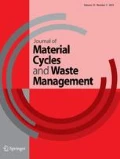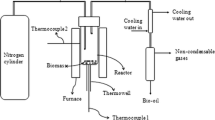Abstract
With growing concerns of fossil fuel resources availability and the volatility of crude oil price, it is becoming imperative day by day to utilize the renewable sources of energy in a sustainable, environment friendly and energy efficient manner. India is the world’s second largest producer of cotton after China. India also has several agricultural and forest residues, and cotton residue is one of the most abundant agricultural residues after rice and wheat residues. The hydropyrolysis of cotton residues has been carried out at various pressures (1, 20 and 40 bar) and temperatures (300, 350, 400 and 450 °C). The effects of temperature and pressure have been studied to understand their yield patterns, and it has been observed that 20 bar pressure and 400 °C are the optimum conditions. The thermogravimetric analysis shows that cotton residue has two significant decomposition temperatures. The SEM, XRD patterns and FT-IR spectra clearly indicate the decomposition of the macromolecular structure of the cotton residue and formation of low molecular weight hydrocarbons suitable for various applications.






Similar content being viewed by others
References
Huber GW, Corma A (2007) Synergies between bio- and oil refineries for the production of fuels from biomass. Angew Chem Int Ed 46:7184–7201 Angew Chem 119:7320–7338
Cherubini F (2010) The biorefinery concept: using biomass instead of oil for producing energy and chemicals. Energy Convers Manag 51:1412–1421
http://www.organiccotton.org/oc/Cotton-general/World-market/World-cotton-production.php. Accessed 18 Dec 2013
Cotton Incorporated. Monthly Economic Letter. http://www.cottoninc.com/corporate/Market-Data/MonthlyEconomicLetter/pdfs/English-pdf-charts-and-tables/World-Cotton-Production-Exp.pdf. Accessed 18 Dec 2013
http://cotcorp.gov.in/shares.aspx. Accessed 18 Dec 2013
Sharma-Shivappa RR, Chen Y (2008) Conversion of cotton wastes to bioenergy and value-added products. Transact ASABE (Am Soc Agric Biol Eng) 51(6):2239–2246
Rochester I, King D (2013) Managing cotton stubble/residues. Australian Cotton Production Manual. Chap 18, vol 1, pp 100–102
Pandey SN, Shaikh AJ (1986) A study on chemical composition of cotton plant stalk of different species. Indian Pulp and Paper 41:10–13
Balagurumurthy B, Oza TS, Bhaskar T, Adhikari DK (2013) Renewable hydrocarbons through biomass hydropyrolysis process: challenges and opportunities. J Mater Cycles Waste Manag 15:9–15
Balagurumurthy B, Bhaskar T, Shiva Kumar KLN, Goyal HB, Adhikari DK (2013) Effect of pressure on the hydropyrolysis of Jatropha seed deoiled cake. J Mater Cycles Waste Manag 15(3):328–334
Shaikh AJ, Gurjar RM, Patil PG, Paralikar KM, Varadarajan PV, Balasubramanya RH (2012) Particle boards from cotton stalk. http://www.icac.org/tis/regional_networks/asian_network/meeting_5/documents/papers/PapShaikhA.pdf. Accessed 18 Dec 2013
Wang L, Trninic M, Skreiberg O, Gronli M, Considine R, Antal MJ (2011) Is elevated pressure required to achieve a high fixed-carbon yield of charcoal from biomass? 1. Round robin results for three different corncob materials. Energy Fuel 25(7):3251–3265. doi:10.1021/ef200450h
Acknowledgments
The authors thank The Director, CSIR-Indian Institute of Petroleum, Dehradun, for his constant encouragement and support. RS thanks Council of Scientific and Industrial Research (CSIR), New Delhi, India, for providing Senior Research Fellowship (SRF). The authors thank CSIR in the form of XII Five Year Plan project (CSC0116/BioEn) and Ministry of New and Renewable Energy for providing financial support.
Author information
Authors and Affiliations
Corresponding author
Rights and permissions
About this article
Cite this article
Balagurumurthy, B., Singh, R., Oza, T.S. et al. Effect of pressure and temperature on the hydropyrolysis of cotton residue. J Mater Cycles Waste Manag 16, 442–448 (2014). https://doi.org/10.1007/s10163-014-0250-1
Received:
Accepted:
Published:
Issue Date:
DOI: https://doi.org/10.1007/s10163-014-0250-1




